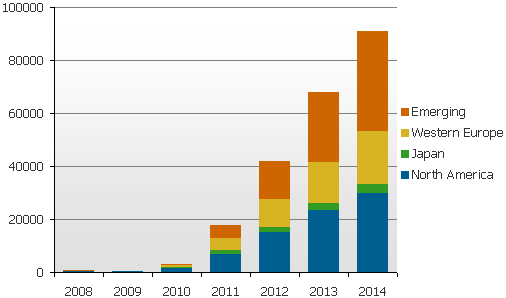 DisplaySearch announced it estimates 3.2 million 3DTVs were sold in 2010 and forecasts that 3DTV sales will rise to 91 million sets by 2014.
DisplaySearch announced it estimates 3.2 million 3DTVs were sold in 2010 and forecasts that 3DTV sales will rise to 91 million sets by 2014.
For more information visit: www.displaysearch.com
Unedited press release follows:
3D TV Forecast to Reach 3.2 Million Global Shipments in 2010 and 91 Million in 2014
Mature Markets Driving Segment Growth, While Only 4% of TVs 40”+ had 3D Capabilities
SANTA CLARA, CALIF., January 4, 2011—The availability of 3D content will remain the greatest determinant of the value of 3D TVs to consumers – and as a result its achievable premium in TV sets. 3D TVs were launched with much fanfare at IFA 2009, but a year ago at CES, the first real products reached the market. Since then, shipments have made steady, although slightly disappointing, progress. Global shipments in 2010 were expected to total 3.2 million worldwide, according to the DisplaySearch Quarterly TV Design and Features Report.
“TV manufacturers really got ahead of themselves in 2010, and they forgot that a TV is a tool to watch content,” said Paul Gray, Director of TV Electronics Research at DisplaySearch. “People will only buy a 3D TV if there is enough content to watch, and in 2010, there simply was not enough 3D content available. As a result, only 4% of TVs 40” and larger had 3D capabilities.”
Despite this, competitive pressures in the industry are rapidly making 3D a compulsory feature. DisplaySearch forecasts that nearly 18 million 3D sets will be shipped in 2011, rising to over 91 million in 2014.
“TV set makers are strongly committed to 3D, and they expect their strong lead to encourage content creators to follow,” Gray added. “Weakness in the North American TV market was largely to blame for slow 3D shipments, although our research shows that only 40 3D Blu-ray disc titles were available across all genres at the end of 2010.”
Figure 1: Forecast 3D TV Unit Shipments (000’s) by Region
Source: DisplaySearch Q4’10 Quarterly TV Design and Features Report
The DisplaySearch Quarterly TV Design and Features Report also examines systems with 3D passive glasses, which launched in China in December 2010 and are expected to be featured at CES. These are being offered as an alternative to the existing shutter glasses types, which have significant drawbacks, including high costs, weight, the need for re-charging, and limited interoperability.
“What is disturbing, though, is the prospect of a format war,” said Gray. “It would be very damaging and consumers would opt to wait if they sense obsolescence, especially when they are already cautious about spending.”
Other key findings from the Q4 report include:
* In the global broadcast environment, South African countries have opted to jump straight to the latest DVB-T2 broadcast standard. DisplaySearch forecasts that almost 20 million TV sets will ship with DVB-T2 decoding in 2015.
* 21% of all TVs shipped in 2010 are forecast to have internet connectivity. This category is forecast to grow to over 122 million in 2014, with emerging markets providing a significant portion of the growth as broadband adoption surges.
* TV set makers are addressing the new opportunities in emerging markets for flat panel TVs, with TV products being launched that are customized to consumers in these regions. Low power consumption, resilience to electricity supply failure, robust reception, and different local preferences are being actualized in new TV models.
The DisplaySearch Quarterly TV Design and Features Report is a quarterly update of the rapid shifts in TV feature development. The 200+ page report examines and forecasts video processor and signal processing IC market development, including 120/100 and 200/240 Hz frame rates and market shares for major IC vendors. In addition, the report features forecasting for MPEG-4 decoding and the digital broadcast environment around the world, including a forecast for DVB-T2; TV connectivity, such as wired and wireless networked TVs; LED backlighting; 3D capability and implementation; remote controls and chassis design; and power consumption. The report also outlines national digital broadcast timetables for 91 countries, and forecasts the shipment of TV sets by digital broadcast standard or connected TV by region.
About DisplaySearch
Since 1996, DisplaySearch has been recognized as a leading global market research and consulting firm specializing in the display supply chain, as well as the emerging photovoltaic/solar cell industries. DisplaySearch provides trend information, forecasts and analyses developed by a global team of experienced analysts with extensive industry knowledge and resources. In collaboration with the NPD Group, its parent company, DisplaySearch uniquely offers a true end-to-end view of the display supply chain from materials and components to shipments of electronic devices with displays to sales of major consumer and commercial channels.
About The NPD Group, Inc.
The NPD Group is the leading provider of reliable and comprehensive consumer and retail information for a wide range of industries. Today, more than 1,800 manufacturers, retailers, and service companies rely on NPD to help them drive critical business decisions at the global, national, and local market levels. NPD helps our clients to identify new business opportunities and guide product development, marketing, sales, merchandising, and other functions. Information is available for the following industry sectors: automotive, beauty, commercial technology, consumer technology, entertainment, fashion, food and beverage, foodservice, home, office supplies, software, sports, toys, and wireless.
